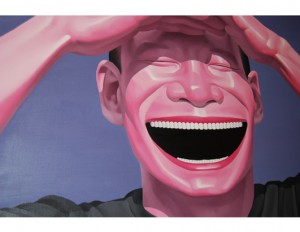Are You Happy? Hedonic or Eudaemonic?

Eudaemonia!
Research on happiness often distinguishes between two types: affective happiness and evaluative happiness. Affective happiness is how you’re feeling now and in the recent past. It’s fairly volatile and can rise or fall quickly. Evaluative happiness measures how happy you are with your life. It tends to be more stable.
Both types of happiness fit into a broader category generally known as the hedonic theory of happiness. This is essentially the pleasure principle – we seek pleasure and avoid pain. It’s fairly straightforward and is often considered the ultimate goal in theories of positive thinking.
But let’s think critically about this. Is pleasure really all there is to happiness? When you overcome obstacles in life, doesn’t that make you happy, even if the process is painful? Can you be happy simply by thinking positively and banishing negative thoughts? Indeed, can you truly banish negative thoughts and emotions?
These questions lead to a different theory of happiness that’s often known as the eudaemonic perspective. In Western thought, the concept originated with Aristotle. The basic idea is that we should lead an actively engaged life, colored by virtue and excellent character. It’s often compared to what Mihaly Csikszentmihalyi calls flow – when you’re completely immersed in what you’re doing. You harness your emotions toward a task and become completely absorbed by it.
When you’re fully engaged, negative thoughts may arise just as easily as positive thoughts. Rather than trying to suppress negative thoughts, you simply let them flow by. They’re part of who we are. In fact, they probably have some survival value. They can spur you to take action against an obstacle, do something unpleasant but necessary, or even just take your medicine.
Indeed, it may well be the case that trying to suppress negative thoughts causes us to have more of them rather than fewer. As Tori Rodriguez reports, a phenomenon called dream rebound may come into play. Researchers at the University of New South Wales divided participants into two groups. One group was asked to suppress a negative thought just before falling asleep. The other group did not try to suppress their thoughts. Those who tried to suppress their negative thoughts reported dreaming about it more frequently than those who didn’t. (Though it’s a different realm, this is similar to Jevon’s paradox).
In my experience, negative thinking produces a second-order effect. First, we have a negative thought. Second, we get wound up about having negative thoughts. OMG, am I a negative person? Why do I have such negativity?
In my opinion, the second-order effect is more damaging than the first. Of course we’re going to have negative thoughts. We can’t avoid them. In fact, they probably help us survive. The trick is to let them pass. As the Tibetans say, thinking is like writing on water. It goes away. Allowing negative thoughts to flow may not lead us to hedonic happiness but may very well stimulate eudaemonic happiness.
Why Your Dog Is Happier Than You Are

The door’s opening!
Story 1: When I come home, I open the front door and our dachshund, Bella, comes racing through the house, throws herself at my feet, rolls over for a belly rub, and wags her tail vigorously. It doesn’t matter if I’ve been outside for a few minutes or away on a business trip for a few days. Bella’s reaction is always the same – she’s thrilled to see me.
Story 2: Suellen and I enjoy art and we’re friends with several artists, so we have a lot of artsy things – photographs, etchings, a few paintings, and sculptures. Some of it is pretty good stuff. Even the not-so-good stuff has lots of sentimental value. I notice, however, that I don’t notice the art so much. I can walk through the house without registering that it’s filled with art. It’s almost like wallpaper.
Why is it that Bella gets excited just by hearing the door creak open while I can blithely ignore some very stimulating art? I think it’s because of hedonic adaptation. I have it. Bella doesn’t.
When we acquire a new piece of art, I pay a lot of attention to it. I may study it, talk about it, maybe even brag about it. It’s new and different and it stimulates me. After a few months, however, it’s just part of the new normal. I still like the piece but it doesn’t stimulate me. I’ve adapted to its presence. That’s hedonic adaptation (or the hedonic treadmill as it’s sometime called).
Bella, on the other hand, doesn’t seem to grow accustomed to the same old thing. Everything seems new to her all the time. The door creaks and off she goes to a new adventure. At the very least, she’ll get a belly rub. She might even get a treat. Oh, it’s so exciting!
There’s a subtler difference as well. Art is a thing, something to be owned. An opening door is an experience: who knows what will happen? There’s a bundle of evidence that experiences generate more happiness than things. If you want to improve your general level of happiness (and perhaps get off the hedonic treadmill for a while), invest in doing things rather than buying things.
I’ve written about happiness before (click here and here and here). There’s a rising tide of research on Gross National Happiness and a suggestion that we over-emphasize Gross National Product in public policy. For instance, American wealth has tripled in the past half century but we haven’t gotten any happier. Relative wealth seems more important than absolute wealth.
What about at the personal level? The best advice seems to be to invest in small experiences. Why small rather than big? Because you can do them more often. Frequency seems to be more important than size. There’s a novelty factor that seems to intrigue and stimulate us. Bottom line: do more things, buy fewer things. Oh, and get a dog.
Does Happiness Cause Innovation? Or Vice-Versa?
Does happiness cause innovation? Or is it the other way round: does innovation cause happiness? Or is there a third variable that causes both happiness and innovation to vary together?
In the past, I’ve written about measures of national happiness (here and here) and measures of innovation (here, here, and here). I’ve been wondering: are happiness and innovation correlated? It seems like a reasonable thought but I haven’t had any evidence to make an inference. Until now.
I’ve just been reviewing the Global Innovation Index of 2012 (the GII) as published by INSEAD (the business school) in conjunction with the World Intellectual Property Organization (part of the UN). One of the goals of the GII is to develop effective measures of innovation that can be applied at the national level. INSEAD has published the report annually since 2007. Each year, it evolves and adds new variables. In theory, each year it becomes a better reflection of the true state of innovation around the world. In the 2012 edition, the report incorporates about 80 different variables.
What struck me immediately was the relationship between the GII and the World Happiness Report that I’ve written about before. While researching this article, I also stumbled across the Legatum Institute‘s ranking of national happiness. Though Legatum uses a different method, the results closely match the World Happiness Report. Indeed, the top ten countries in each report are the same — though in different order.
So, how does happiness relate to innovation? Look at the table below, which compares the top ten countries in the World Happiness Report (WHR), Legatum, and the Global Innovation Index (GII). Half of the top ten most innovative countries (with *) are also among the world’s happiest countries. The correlation seems to grow stronger if you look past the top ten. For instance, the USA is 11th on the WHR and ninth on the GII. Similarly, Canada, New Zealand, and Norway are 11th, 12th, and 13th on the GII and all three are in the top ten of both WHR and Legatum.
Why should happiness be related to innovation? I’m not at all sure. Part of the reason I’m publishing this is to ask my readers: what do you think? Let’s gather the best ideas and see if we can test them logically. Over to you.
| WHR | Legatum | GII | ||
| 1 | Denmark | Norway | Switzerland | * |
| 2 | Finland | Denmark | Sweden | * |
| 3 | Norway | Sweden | Singapore | |
| 4 | Netherlands | Australia | UK | |
| 5 | Canada | New Zealand | Netherlands | * |
| 6 | Switzerland | Canada | Denmark | * |
| 7 | Sweden | Finland | Hong Kong | |
| 8 | New Zealand | Netherlands | Ireland | * |
| 9 | Australia | Switzerland | USA | |
| 10 | Ireland | Ireland | Luxembourg |
What Makes You Happy?
 Are you happy? Would that be “affective happiness” or “evaluative happiness”?
Are you happy? Would that be “affective happiness” or “evaluative happiness”?
Affective happiness has to do with day-to-day life and emotions. It can go up or down quickly depending on how your day is going. Evaluative happiness is your overall evaluation of your life. How happy are you with your place in society? Think of it as overall life satisfaction.
So what makes people happy? I’m glad you asked since I’ve been reading the World Happiness Report. (For my earlier article on Gross National Happiness, click here. For the full Report, click here.) The Report summarizes surveys and statistics from around the world and develops some surprising conclusions about what contributes to evaluative happiness. Here’s a look at a few of the variables.
Income — you might think that richer people are happier. To a degree, you’re right — but income works in strange ways. First, richer people are generally happier than poorer people but the quest for higher income can reduce happiness. Second, as countries grow richer, they don’t necessarily grow happier. GNP per capita has risen threefold in the U.S since 1960, yet we’re not happier. That’s partially because happiness is tied more to relative income rather than absolute income. If we all get richer at more or less the same rate, then our relative positions don’t change — nor does our happiness. Third, there seems to be an income limit. Up to a certain level, income seems to increase happiness. Beyond that level, more income does not yield more happiness. Ultimately, differences in income explain about 1% of the variance in evaluative happiness.
Marriage – “Marriage is one of the unambiguous, universally positive and statistically significant correlates of life satisfaction.” But what’s the cause and what’s the effect? Does marriage make people happy or do happy people get married? It seems to be a bit of both. People who are happier when they’re young are more likely to get married. But marriage then gives a happiness boost — over and above the “normal” rate of happiness.
Age — as you get older, your body starts to break down physically and mentally. So you should be less happy, right? Not quite. There’s a big U-turn when you relate age to happiness. Other things being equal, we’re happier when we’re young and then happiness declines until we reach our 40s. Then things brighten up again and our life satisfaction rises. Could it be the wisdom of maturity? Maybe. Or maybe we can just afford better wine.
Gender — “In most advanced countries women report higher satisfaction and happiness than men.” This is less true in poorer countries but seems to be universally true in richer, more advanced countries.
Education — the evidence is mixed. More education doesn’t correlate directly with greater happiness. But it does contribute indirectly in that more education generally results in higher income which can create greater happiness.
Children — “Surprisingly, the presence of children in the household appears not to be associated with higher life satisfaction.”
Television — “Many studies have shown that watching TV is associated with lower happiness, other things equal. An early study exploited the fact that one Canadian town gained access to TV some years later than other towns. The result was a relative fall in social life and increased aggression.” Additionally, TV watchers see many rich people on the tube and tend to underestimate their own relative income. As we saw earlier, your perception of your income relative to others is what counts in happiness.
There’s much more to it — including mental health, freedom, corruption, equality, and community — but I think I’ll stop here for the moment. Does that make you happy?
Gross National Happiness

We’re happy in Denmark.
What’s with these Danes? On virtually every survey that purports to measure national happiness — or Gross National Happiness — Denmark scores number one. In fact, the Nordic countries — Denmark, Finland, Iceland, Norway and Sweden — typically occupy half of the top ten “happy slots”. I’ve visited all the Nordic countries. They’re really nice but are they the happiest places in the world? Wasn’t Hamlet Danish? He didn’t seem so happy.
As you may have guessed, I’ve been reading the World Happiness Report published through The Earth Institute at Columbia University. (Click here). It’s about 170 pages long and makes for very interesting reading — enough so that I’m going to write about various facets of it from time to time. Here are some of the key questions:
- Is happiness a topic that we can take seriously? According to the study’s authors, there is enough empirical research coming from many different cultures that we can start to make useful comparisons and judgments. I’ll admit that I’m very curious about how to measure national happiness, so I’ll write about the method as well as the results.
- What makes people happy? Money helps but not as much as other factors like social cohesion, strong family ties, absence of corruption, and degree of personal freedom. Interestingly, giving money away seems to make people happier than receiving money.
- As countries get richer, do they get happier? Some do and some don’t. Apparently, the USA is one of those countries that hasn’t gotten happier as we’ve gotten richer. I’d like to dig into that.
- Is the world getting happier? Apparently we are, especially in areas where extreme poverty is being eliminated.
I’ll write occasionally on happiness studies and delve into what makes people happy and what doesn’t — and how all this affects the way we live. Feel free to send me any of your questions about happiness studies and I’ll try to get them answered.
In the meantime here are two questions for you:
- Taking all things together, how happy would you say you are? (0 = extremely unhappy; 10 = extremely happy)
- All things considered, how satisfied are you with your life nowadays? (0 = extremely dissatisfied; 10 = extremely satisfied).
In the Nordic countries, the average life satisfaction score is 7.6. If yours is lower than that, maybe it’s time to head to Denmark.
